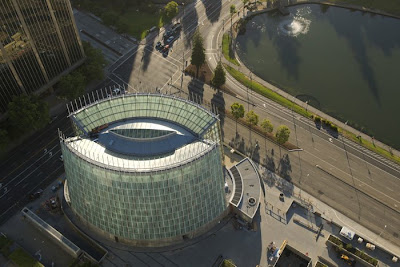In Oakland, the "Light" Is On
 It won't be formally dedicated for another week and a half, but the nation's newest cathedral -- Oakland's iconoclastic, postmodern Christ the Light (photos) -- opens to the public today.
It won't be formally dedicated for another week and a half, but the nation's newest cathedral -- Oakland's iconoclastic, postmodern Christ the Light (photos) -- opens to the public today.After three years of construction and a final procession from St Francis de Sales -- the parish church first used as the East Bay diocese's seat until it was critically damaged in the 1989 Loma Prieta earthquake -- representatives of the 600,000-member local church will launch the 1,350-seat lakeside space at a 2pm "Service of Light" led by Bishop Allen Vigneron. Meanwhile, opening weekend's seeing a special collection in the diocese's 84 parishes aimed at lessening the $75 million shortfall the $190 million project still faces.
But with its moniker inspired by Lumen Gentium -- and its ministry plans reflective of the document's ecclesiology -- Priority #1 for the new complex is twofold: establishing the site as the "symbol of the Catholic presence" in the city through its worship and social outreach, and circling the wagons of an especially diverse, vibrant, diocesan community.
The latter took center-stage as San Fran's Chronicle got a sneak peek:
The diocese has built this cathedral - a many-centuries-old concept of creating a universal identity for a diocese - as Catholic identity is increasingly fragmented along ethnic lines. In this diocese alone, the church's multiculturalism means that Mass is offered in 13 languages.
The obstacles to creating community hardly deter Vigneron, for whom the cathedral becomes a seat of influence as well as his residence. The diocese and its 600,000 parishioners - a population that would make it the Bay Area's third largest city - have staked $190 million in construction costs on the belief that people will come.

"It bespeaks a kind of missionary confidence," said Vigneron. "With the attractiveness of the message of Christ, we can build up the congregation."...Daring though its design might be, it's worth noting that the guiding principle behind Christ the Light isn't really all that new -- fusing the ancient and modern in the sun's clear glow was, after all, the asthetic concept employed in the building of Stateside Catholicism's mother-temple: Baltimore's Basilica of the Assumption.
Yet the cathedral already finds itself struggling with the delicate balance between creating space for every community and the challenges of building collective identity.
Parishioners have been told they will need permission to put flowers on the altar, and Filipinos have been told they can no longer sing "Our Father" in Tagalog, a revered tradition, said Priscilla Cardona, 60, a parish councilmember of the Parish of Christ the Light. And Vigneron said the Christ the Light parish's tradition of regularly bringing all ethnic communities together for a joint Mass, with a homily in English, might not continue at the cathedral....
Vigneron said the absence of a cathedral created "a decreased sense of ourselves as all the Catholics of the East Bay as one community of faith" - a critical part of Catholic identity....
Some parishioners worry the intimate sense of community they've had will be lost in a cathedral seating 1,350. Others worry they won't be able to serve in the same way, such as helping prepare for Mass, and that they'll be treated the same as the half a million others in the diocese. There are emotional reasons, too.
 Yet even with that in mind -- and, indeed, much like the story both represent -- the arc from Latrobe's masterpiece in the East to its modern-day answer in the West is nothing less than dramatic.
Yet even with that in mind -- and, indeed, much like the story both represent -- the arc from Latrobe's masterpiece in the East to its modern-day answer in the West is nothing less than dramatic.PHOTO: Michael Macor/San Francisco Chronicle(1); John Blaustein(2)
-30-

<< Home